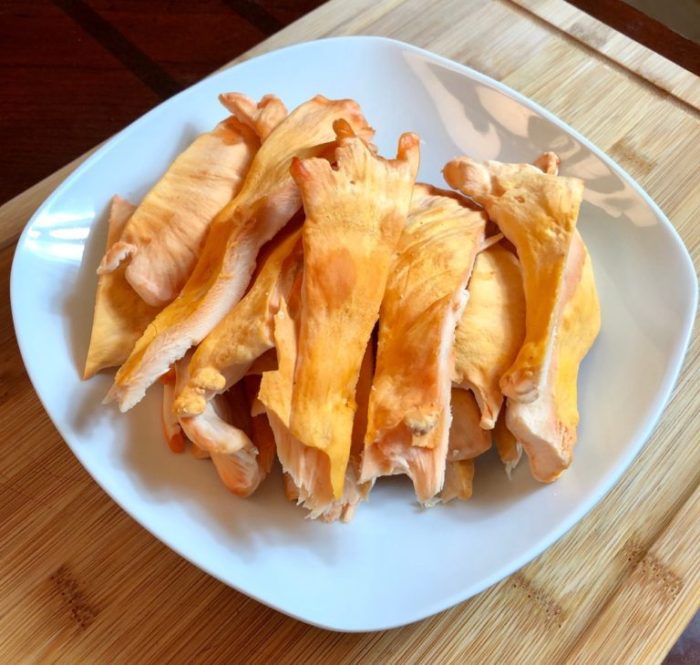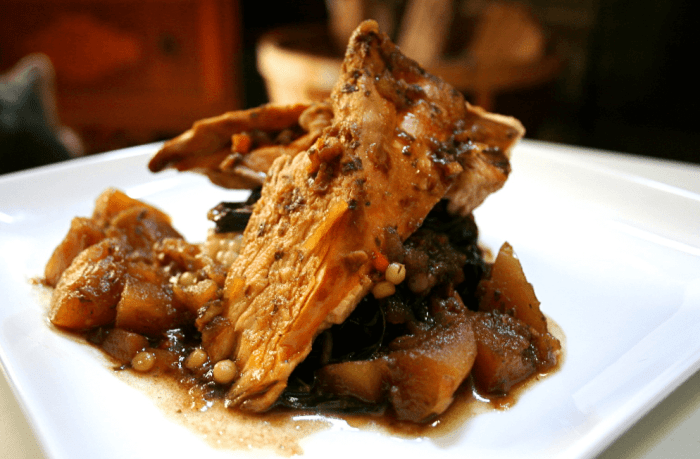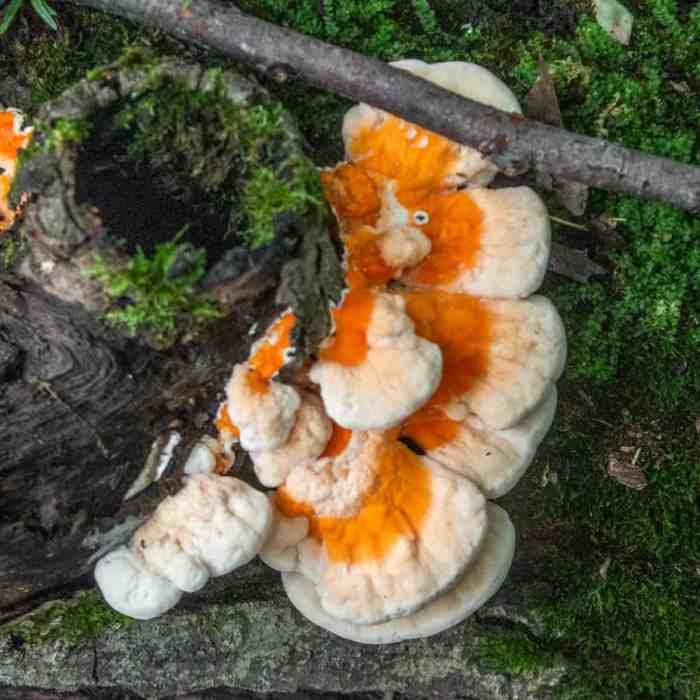
Unveiling the tantalizing world of chicken of the woods recipe, we embark on a culinary journey that unveils the unique flavors and versatility of this woodland delicacy. From its distinct characteristics to its diverse culinary applications, prepare to be captivated by the magic of chicken of the woods.
Delving into the depths of this delectable mushroom, we explore its seasonality, habitats, and the art of harvesting. Discover the secrets of proper handling and storage, ensuring the preservation of its vibrant flavors. With expert guidance, we unravel the culinary possibilities that await, inspiring you to create mouthwatering dishes that celebrate the essence of chicken of the woods.
Introduction to Chicken of the Woods

Chicken of the Woods ( Laetiporus sulphureus) is a vibrant and distinctive mushroom that has captured the attention of culinary enthusiasts and foragers alike. Its striking appearance, reminiscent of succulent chicken meat, sets it apart from its counterparts in the fungal kingdom.
This culinary gem is highly prized for its meaty texture and savory flavor profile, making it a versatile ingredient in various culinary creations. Its seasonality, from late spring to early fall, and its prevalence in hardwood forests, particularly around oak trees, make it a sought-after delicacy.
Availability and Seasonality
Chicken of the Woods is a seasonal delicacy, gracing our presence from late spring to early fall. Its availability varies depending on geographical location, but it typically flourishes in temperate regions with ample moisture and warm temperatures.
Foraging for Chicken of the Woods requires patience and keen observation. It often emerges in clusters at the base of oak trees or on fallen logs, its bright orange or yellow coloration standing out amidst the forest floor. Responsible foraging practices, such as identifying the mushroom accurately and harvesting only mature specimens, ensure the sustainability of this precious resource.
Harvesting and Preparation
Identifying and harvesting Chicken of the Woods is a crucial step in enjoying this delicious delicacy. It’s essential to understand its characteristics and proper handling techniques to ensure a safe and flavorful experience.
When foraging for Chicken of the Woods, look for its distinctive fan-shaped clusters. They typically range in color from bright orange to yellow and have a velvety texture. Avoid mushrooms with bruises or signs of decay. Always harvest from healthy, mature specimens.
Proper Handling and Storage
After harvesting, handle Chicken of the Woods with care to preserve its freshness. Gently brush off any dirt or debris and store the mushrooms in a paper bag or perforated container in the refrigerator. They should be used within a few days of harvesting to maintain their optimal flavor and texture.
Cleaning and Preparing
Before cooking, clean the mushrooms thoroughly by wiping them with a damp cloth or rinsing them briefly under cold running water. Avoid soaking them as they can absorb excess moisture. Trim any tough or woody parts and cut the mushrooms into desired shapes and sizes.
Culinary Applications

Chicken of the Woods is a versatile culinary delight that offers a wide range of culinary applications. Its unique flavor and texture make it a favorite among foragers and chefs alike.
The versatility of Chicken of the Woods extends from sautéing and roasting to grilling and stewing. Each cooking method brings out distinct flavors and textures, allowing for a diverse culinary experience.
Sautéing
Sautéing Chicken of the Woods in a pan with butter or oil is a quick and easy way to enjoy its savory flavors. The high heat caramelizes the mushroom’s exterior, creating a crispy crust while maintaining a tender interior.
For those seeking a unique culinary experience, the chicken of the woods recipe is a must-try. This flavorful mushroom can be prepared in a variety of ways, including stir-frying or grilling. For a more traditional approach, refer to the chicken of the woods recipe provided by Weber, a leading barbecue manufacturer.
To sauté Chicken of the Woods, heat a pan over medium heat. Add butter or oil and sauté the mushroom slices for 5-7 minutes, or until golden brown. Season with salt and pepper to taste.
Roasting
Roasting Chicken of the Woods in the oven is another excellent way to cook it. Roasting allows the mushroom to develop a deep, earthy flavor while retaining its moist texture.
To roast Chicken of the Woods, preheat the oven to 400°F (200°C). Toss the mushroom slices with olive oil, salt, and pepper. Spread them on a baking sheet and roast for 15-20 minutes, or until tender and slightly browned.
Grilling
Grilling Chicken of the Woods over an open flame adds a smoky flavor to the mushroom. Grilling is perfect for creating a charred exterior while keeping the interior juicy and flavorful.
To grill Chicken of the Woods, preheat a grill to medium heat. Brush the mushroom slices with olive oil and season with salt and pepper. Grill for 5-7 minutes per side, or until cooked through.
Stewing, Chicken of the woods recipe
Stewing Chicken of the Woods in a flavorful broth is a great way to extract its rich flavors. Stewing allows the mushroom to absorb the flavors of the broth, creating a delicious and comforting dish.
To stew Chicken of the Woods, heat a pot over medium heat. Add olive oil and sauté the mushroom slices for 5 minutes. Add broth, vegetables, and seasonings. Bring to a simmer and cook for 30-45 minutes, or until the mushroom is tender and the broth is flavorful.
Nutritional Value and Health Benefits

Chicken of the Woods boasts an impressive nutritional profile, packed with essential vitamins, minerals, and antioxidants that contribute to overall well-being.
One serving (100 grams) of Chicken of the Woods provides:
- Calories: 38
- Protein: 3.2 grams
- Carbohydrates: 7.2 grams
- Fiber: 2.5 grams
- Vitamin C: 15% of the Daily Value (DV)
- Vitamin D: 10% of the DV
- Potassium: 8% of the DV
- Phosphorus: 6% of the DV
- Antioxidants: Beta-glucans, ergothioneine
Immune System Support
Chicken of the Woods contains beta-glucans, a type of soluble fiber known for its immune-boosting properties. Beta-glucans stimulate the immune system by activating macrophages and natural killer cells, which play a crucial role in fighting infections and diseases.
Antioxidant Activity
Chicken of the Woods is rich in antioxidants, including ergothioneine, which has been shown to protect cells from oxidative damage caused by free radicals. Antioxidants neutralize free radicals, preventing them from damaging DNA, proteins, and other cellular components.
Incorporating Chicken of the Woods into a Healthy Diet
Chicken of the Woods is a versatile mushroom that can be incorporated into various healthy dishes. It can be sautéed, grilled, roasted, or added to soups, stews, and salads. Its mild, slightly sweet flavor complements many other ingredients, making it an excellent choice for vegetarians and meat-eaters alike.
Culinary Pairings and Variations: Chicken Of The Woods Recipe

Chicken of the Woods is a versatile culinary delight that pairs well with a range of flavors and ingredients. Its meaty texture and mild taste make it an excellent canvas for exploration.
For a classic pairing, consider sautéing Chicken of the Woods with garlic, onions, and herbs. This simple preparation allows the natural flavors of the mushroom to shine through.
Marinades and Sauces
Marinating Chicken of the Woods enhances its flavor and tenderness. Try a marinade made with olive oil, soy sauce, and spices like thyme or rosemary.
If you’re looking to explore a more regional take on the chicken of the woods, check out the chicken of the woods recipe from Northeastern Connecticut Planning Region. Their recipe incorporates local flavors and ingredients, ensuring an authentic culinary adventure.
Sauces can elevate the dish to new heights. A creamy mushroom sauce or a tangy barbecue sauce complements the mushroom’s earthy flavor.
Cooking Variations
Chicken of the Woods can be cooked in various ways, each offering a unique texture and flavor profile.
- Sautéing:This method yields tender and juicy mushrooms.
- Grilling:Grilling imparts a smoky flavor and a slightly crispy exterior.
- Roasting:Roasting intensifies the mushroom’s umami flavor and creates a slightly caramelized crust.
Garnishes
Garnishes add a touch of elegance and enhance the overall presentation of the dish.
- Fresh herbs like parsley or cilantro
- Grated Parmesan cheese
- Toasted breadcrumbs
Closure
As we conclude our culinary exploration, the chicken of the woods recipe stands as a testament to the boundless creativity and versatility of this remarkable mushroom. Its nutritional value and health benefits further enhance its appeal, making it a culinary treasure that nourishes both body and soul.
Whether sautéed, roasted, grilled, or stewed, chicken of the woods invites experimentation and culinary exploration. Embrace the flavors of the forest and let the chicken of the woods recipe inspire your next culinary masterpiece.
Question Bank
Can chicken of the woods be eaten raw?
No, chicken of the woods should not be consumed raw. Cooking helps to release its flavors and textures, while also ensuring its safety for consumption.
What are the best ways to cook chicken of the woods?
Chicken of the woods can be sautéed, roasted, grilled, or stewed. Each method imparts unique flavors and textures, allowing you to explore its versatility.
How can I identify chicken of the woods in the wild?
Chicken of the woods is characterized by its bright orange to yellow coloration, shelf-like growth pattern, and soft, velvety texture. It typically grows on dead or dying hardwood trees.





